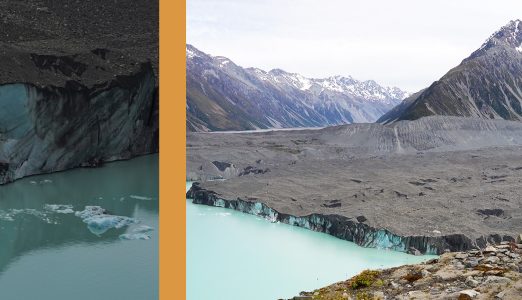
A post-human understanding of anthropogenic landscapes- bookending the 2020 Australian summer fires between the sonic memories of the lyrebirds and the reflective properties of ice.
Considering these two landscapes, connected now by the ash and dust from the fires, embedded in glacial ice. To reflect one within the other; the birds narration of its bush, echoed to the NZ glacier landscape of the NZ Southern Alps / Kā Tiritiri o te Moana.
Commissioned for Ever Ending, POST Projects Nijmegen, Netherlands. Curated by Lieke Wouters with works by Penelope Cain, Mel Chan, Sonia Kazovsky and Mariana Marangoni
4 screen video and sound, pigment, feathers
Four lyrebird songs from four forests affected in the Black summer fires, east coast Australia, were played to four glaciers in the Southern Alps of New Zealand/ Kā Tiritiri o te Moana, where the ash and dust from these fires landed.
For more information about research: HERE
The Balangara / Dyagula/ Menura novaehollandiae/ superb lyrebird sings the song of many birds. Lyrebirds are excellent mimics, performing a sonic recollection of all the birdlife in the forest around them; the oral historians and narrators of the bush. Their mimicry skills are so profound that other bird species can’t tell the difference between lyrebird mimicry and their own species’ calls.
The Black Summer fires of eastern Australia (2019-220) was the worst in recorded history. It burned over 512,000 hectares of trees, killed or displaced 3 million animals and took 3 months to fully contain. 50% of lyrebirds along the east coast were lost in the 2020 fires: burned or subsequently starved, and all of their sonic memories of their forest valleys gone.
Ash and dust from this fire was windborn across the Tasman Sea to land on the Southern Alps of New Zealand/ Kā Tiritiri o te Moana.
It has been calculated that the ash and dust from the black summer Australian fires (2020) covered 90% of the total glaciated area of the NZ South Island.
Researchers from Victoria University, Wellington and Manaaki Whenua Landcare NZ are studying this ash and dust event to model the impact of future hotter drier climates and increased Australian fires on glacier longevity.
We are contaminated by our encounters…’ writes Anthropologist Anna Tsing
Of tongues and tongues; glacier and bird. Of glacial faces and glacial heads, and avian voices and forest ears.
Hear us, you who are no more than leaves always falling, you mortals benighted by nature, You enfeebled and powerless creatures of earth always haunting a world of mere shadows, Entities without wings, insubstantial as dreams, you ephemeral things, you human beings: Turn your minds to our words, our ethereal words, for the words of the birds last forever!
—Aristophanes, The Birds
References and notes :
This line of inquiry connects animal behaviour research, bird studies from habitat loss, glacial studies and snow micro-climate research.
Lyrebird sounds and footage collected primarily from Dharug and Gundungurra country/ Blue Mountains, on which much of the fires occurred.
With thanks to JJ Emerson for footage and sound. With thanks to Del for footage.
With thanks to Dr Phil Novis + Dr John Hunt and Manaaki Whenua – Landcare Research, Lincoln NZ
With thanks to Dr John Hunt for video footage taken the day after ash/ dustfall, Haupapa/ Tasman Glacier, NZ.















